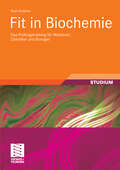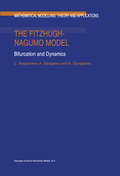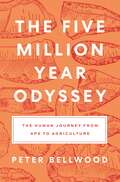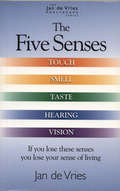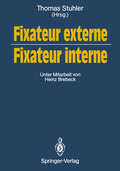- Table View
- List View
Fit fürs Labor: Molekularbiologie und Zellbiologie
by Alan J. Hargreaves Philip L.R. BonnerSouverän durchs Praktikum: Macht Studierende der Biologie, Biochemie oder Biotechnologie fit für die ungewohnte Arbeitsumgebung eines wissenschaftlichen Labors Fit fürs Labor: Molekularbiologie & Zellbiologie gibt Studierenden in den Biowissenschaften ein kompaktes Nachschlagewerk an die Hand, das alle wesentlichen molekularbiologischen und zellbiologischen Arbeitsmethoden erklärt. Von der Extraktion über die Aufreinigung zur Funktionsbestimmung von Nukleinsäuren und Proteinen, grundlegenden Zellkulturtechniken und immunchemischen Verfahren wird die Bandbreite biowissenschaftlicher Labortechniken abgedeckt. Zu einem erfolgreichen Laborversuch gehört auch die Vorbereitung des Versuchs und der dazu nötigen Materialien, die Dokumentation der gewonnenen Daten sowie deren Auswertung. Daher sind neben Schritt-für-Schritt-Erläuterungen zur Versuchsdurchführung zahlreiche Beispiel zur Analyse und Interpretation der aus dem Experiment gewonnenen Daten enthalten. Vom Ansetzen einer Stammlösung bis zur Durchführung eines biologischen Assays werden alle wichtigen Labortechniken erklärt Mehr als 40 Übungen und Beispielrechnungen sind enthalten, die die typischen Anforderungen und Aufgaben in einem Laborpraktikum abdecken Angereichert mit vielen hilfreichen Definitionen und kleinen Exkursen, die das Leben & Lernen leichter machen Mit Fit fürs Labor: Molekularbiologie und Zellbiologie kann jede und jeder ein biowissenschaftliches Laborpraktikum meistern!
Fit fürs Labor: Molekularbiologie und Zellbiologie
by Alan J. Hargreaves Philip L.R. BonnerSouverän durchs Praktikum: Macht Studierende der Biologie, Biochemie oder Biotechnologie fit für die ungewohnte Arbeitsumgebung eines wissenschaftlichen Labors Fit fürs Labor: Molekularbiologie & Zellbiologie gibt Studierenden in den Biowissenschaften ein kompaktes Nachschlagewerk an die Hand, das alle wesentlichen molekularbiologischen und zellbiologischen Arbeitsmethoden erklärt. Von der Extraktion über die Aufreinigung zur Funktionsbestimmung von Nukleinsäuren und Proteinen, grundlegenden Zellkulturtechniken und immunchemischen Verfahren wird die Bandbreite biowissenschaftlicher Labortechniken abgedeckt. Zu einem erfolgreichen Laborversuch gehört auch die Vorbereitung des Versuchs und der dazu nötigen Materialien, die Dokumentation der gewonnenen Daten sowie deren Auswertung. Daher sind neben Schritt-für-Schritt-Erläuterungen zur Versuchsdurchführung zahlreiche Beispiel zur Analyse und Interpretation der aus dem Experiment gewonnenen Daten enthalten. Vom Ansetzen einer Stammlösung bis zur Durchführung eines biologischen Assays werden alle wichtigen Labortechniken erklärt Mehr als 40 Übungen und Beispielrechnungen sind enthalten, die die typischen Anforderungen und Aufgaben in einem Laborpraktikum abdecken Angereichert mit vielen hilfreichen Definitionen und kleinen Exkursen, die das Leben & Lernen leichter machen Mit Fit fürs Labor: Molekularbiologie und Zellbiologie kann jede und jeder ein biowissenschaftliches Laborpraktikum meistern!
Fit in Anorganik: Das Prüfungstraining für alle Naturwissenschaftler und Mediziner (Studienbücher Chemie)
by Rudi HuttererDie Aufgabensammlung „Fit in Anorganik“ besteht aus Aufgaben mit ausführlich ausgearbeiteten und kommentierten Lösungen und verfolgt damit das gleiche Konzept, wie die bereits erschienenen Sammlungen „Fit in Organik“ und "Fit in Biochemie". Inhaltlich orientieren sich die Aufgaben an den vom Gegenstandskatalog vorgegebenen typischen Grundproblemen der allgemeinen und anorganischen Chemie, wie Säuren und Basen, pH-Wertberechnungen, Puffer, Redoxreaktionen, schwer lösliche Verbindungen, Komplexe, chemisches Gleichgewicht, Phasengleichgewichte, Photometrie, Thermodynamik, Kinetik etc. Dieses grundlegende Handwerkszeug wird sowohl für die organische Chemie als auch andere vorklinische Fächer benötigt.
Fit in Anorganik: Das Prüfungstraining für Mediziner, Chemiker und Biologen (Studienbücher Chemie)
by Rudi HuttererDie Aufgabensammlung „Fit in Anorganik“ besteht aus Aufgaben mit ausführlich ausgearbeiteten und kommentierten Lösungen und verfolgt damit das gleiche Konzept, wie die bereits erschienenen Sammlungen „Fit in Organik“ und "Fit in Biochemie". Inhaltlich orientieren sich die Aufgaben an den vom Gegenstandskatalog vorgegebenen typischen Grundproblemen der allgemeinen und anorganischen Chemie, wie Säuren und Basen, pH-Wertberechnungen, Puffer, Redoxreaktionen, schwer lösliche Verbindungen, Komplexe, chemisches Gleichgewicht, Phasengleichgewichte, Photometrie, Thermodynamik, Kinetik etc. Dieses grundlegende Handwerkszeug wird sowohl für die organische Chemie als auch andere vorklinische Fächer benötigt. Die vorliegende zweite Auflage wurde korrigiert und erheblich erweitert. Sie wendet sich auch an Studierende im Bachelor-Studiengang Chemie bzw. Biologie, die reichhaltiges Übungsmaterial, oft mit etwas Hintergrundinformation, zu den Themen finden, die in der allgemeinen und anorganischen Chemie in den ersten Semestern gefordert werden. Zudem wurden die Aufgaben nun thematisch geordnet, um den Zugriff zu bestimmten Aufgabentypen zu erleichtern.
Fit in Anorganik: Das Prüfungstraining für Mediziner, Chemiker und Biologen (Studienbücher Chemie)
by Rudi HuttererDie Aufgabensammlung „Fit in Anorganik“ besteht aus Aufgaben mit ausführlich ausgearbeiteten und kommentierten Lösungen und verfolgt damit das gleiche Konzept, wie die bereits erschienenen Sammlungen „Fit in Organik“ und "Fit in Biochemie". Inhaltlich orientieren sich die Aufgaben an den vom Gegenstandskatalog vorgegebenen typischen Grundproblemen der allgemeinen und anorganischen Chemie, wie Säuren und Basen, pH-Wertberechnungen, Puffer, Redoxreaktionen, schwer lösliche Verbindungen, Komplexe, chemisches Gleichgewicht, Phasengleichgewichte, Photometrie, Thermodynamik, Kinetik etc. Dieses grundlegende Handwerkszeug wird sowohl für die organische Chemie als auch andere vorklinische Fächer benötigt.
Fit in Anorganik: Das Klausurtraining für Mediziner, Pharmazeuten und Biologen (Teubner Studienbücher Chemie)
by Rudi HuttererDie Aufgabensammlung „Fit in Anorganik“ besteht aus Aufgaben mit ausführlich ausgearbeiteten und kommentierten Lösungen und verfolgt damit das gleiche Konzept, wie die bereits erschienene Sammlung „Fit in Organik“. Inhaltlich orientieren sich die Aufgaben an den vom Gegenstandskatalog vorgegebenen typischen Grundproblemen der allgemeinen und anorganischen Chemie, wie Säuren und Basen, pH-Wertberechnungen, Puffer, Redoxreaktionen, schwer lösliche Verbindungen, Komplexe, chemisches Gleichgewicht etc. Dieses grundlegende Handwerkszeug wird sowohl für die organische Chemie als auch andere vorklinische Fächer benötigt. Man denke an Säure-Base-Haushalt im Organismus, das Blut als Puffersystem, Redoxpotentiale in der Atmungskette, Hämoglobin oder Cytochrome als Eisenkomplexe, (schwer lösliche!) Nierensteine, Kopplung von exergonen Reaktionen an endergone als typisches Prinzip im Stoffwechsel usw. Zugleich wird versucht, einige typische Reaktionen der wichtigsten Elemente mit etwas Hintergrundinformation vorzustellen.
Fit in Biochemie: Das Prüfungstraining für Mediziner, Chemiker und Biologen (Studienbücher Chemie)
by Rudi HuttererDie Aufgabensammlung „Fit in Biochemie“ baut auf den beiden erschienenen Titeln „Fit in Anorganik“ und „Fit in Organik“ auf und bildet den Abschluss dieser Reihe. Das hierbei bewährte Konzept wird beibehalten: im Mittelpunkt stehen die ausführlich ausgearbeiteten und kommentierten Lösungen zu den Aufgaben.
Fit in Organik: Das Prüfungstraining für alle Naturwissenschaftler und Mediziner (Studienbücher Chemie)
by Rudi Hutterer„Das Lernen allein genügt nicht, hinzukommen müssen Übung und Gewöhnung“. Das wussten schon die alten Griechen – und es stimmt auch nach mehr als 2000 Jahren noch! Aus meiner Lehrerfahrung heraus, dass die Übung oft zu kurz kommt bzw. passendes, hinreichend ausführlich diskutiertes und interessantes Trainingsmaterial Mangelware zu sein schien, entstanden die Aufgabensammlungen „Fit in Organik“, „Fit in Anorganik“ und „Fit in Biochemie“. Sie sollen Ihnen helfen, sich mit reichlich Übungsmaterial zu allen relevanten grundlegenden Themengebieten der jeweiligen chemischen Teildisziplin solide auf Klausuren bzw. das Physikum vorzubereiten. Dabei werden insbesondere auch zahlreiche Aufgaben zu aus medizinischer, toxikologischer und pharmazeutischer Sicht wichtigen und interessanten chemischen Verbindungen vorgestellt. Inzwischen vielfach bewährt wurde die vorliegende Neuauflage nicht nur erneut deutlich erweitert und mit ca. 100 neuen Aufgaben versehen, sondern auch um ein zusätzliches Tool ergänzt. Den Kapiteln mit den Lösungen wurde ein großer „Werkzeugkasten“ vorangestellt, der – aufgeteilt in sieben „Fächer“ – wesentliche Begriffe, Definitionen und Gleichungen kurz zusammenfasst und so bei Bedarf für eine rasche Wiederholung und zum Nachschlagen dienen soll. Auch innerhalb der einzelnen Kapitel sind die Aufgaben grob thematisch geordnet, sodass sich gezielt ein definiertes Gebiet bearbeiten lässt. Ansonsten wurde das bisherige Konzept beibehalten: mit sehr ausführlich besprochenen Lösungen, insbesondere auch zu den Multiple-Choice-Aufgaben, sowie – insbesondere bei den „Streifzügen durch Pharmakologie und Toxikologie“ – einigen Hintergrundinformationen zu den jeweiligen Wirkstoffen, Toxinen etc.
Fit in Organik: Das Prüfungstraining für Mediziner, Chemiker und Biologen (Teubner Studienbücher Chemie)
by Rudi HuttererDie Chemie ist für die Medizin- und Zahnmedizinstudenten ein Nebenfach, das sich im Allgemeinen nur geringer Beliebtheit erfreut. Umso wichtiger ist es für die Motivation der Studierenden, den Bezug der Chemie zu "ihrem" Fach herzustellen. Die vorliegenden Aufgaben beschäftigen sich daher, am Gegenstandskatalog orientiert, mit biologisch oder pharmakologisch wirksamen Verbindungen - Naturstoffen, Arzneistoffen, Pestiziden und dergleichen. Die Teile I und II des Buches enthalten Aufgaben vom Multiple-Choice-Typ, wie sie Medizinstudenten im Physikum vorgelegt bekommen. Der zugehörige Lösungsteil begnügt sich nicht mit der Nennung der richtigen Lösung, sondern diskutiert jede einzelne Antwortmöglichkeit. Dadurch kann der Studierende exakt nachvollziehen, warum eine einzelne Antwort richtig oder falsch ist. Teil III umfasst Aufgaben, bei denen Antworten frei formuliert werden sollen.
Fit in Organik: Das Prüfungstraining für Mediziner, Chemiker und Biologen (Studienbücher Chemie)
by Rudi HuttererDie Chemie ist für die Medizin- und Zahnmedizinstudenten ein Nebenfach, das sich im Allgemeinen nur geringer Beliebtheit erfreut. Umso wichtiger ist es für die Motivation der Studierenden, den Bezug der Chemie zu „ihrem“ Fach herzustellen.Die vorliegenden Aufgaben beschäftigen sich daher, am Gegenstandskatalog orientiert, mit biologisch oder pharmakologisch wirksamen Verbindungen – Naturstoffen, Arzneistoffen, Pestiziden und dergleichen. Die Teile I und II des Buches enthalten Aufgaben vom Multiple-Choice-Typ, wie sie Medizinstudenten im Physikum vorgelegt bekommen. Der zugehörige Lösungsteil begnügt sich nicht mit der Nennung der richtigen Lösung, sondern diskutiert jede einzelne Antwortmöglichkeit. Dadurch kann der Studierende exakt nachvollziehen, warum eine einzelne Antwort richtig oder falsch ist. Teil III umfasst Aufgaben, bei denen Antworten frei formuliert werden sollen.Die Neuauflage wendet sich auch an Studierende im Bachelor-Studiengang Chemie bzw. Biologie, die hier einfache Problemen zu Reaktionsmechanismen und Synthesen, Naturstoffen und Pharmazeutika finden, wie sie Thema einer typischen Grundvorlesung in organischer Chemie sind. Um den Zugriff zu bestimmten Aufgabentypen zu erleichtern, wurden die Aufgaben grob thematisch sortiert. Die vorliegende dritte Auflage wurde sorgfältig korrigiert. Zirka 35 Aufgaben wurden durch neue Beispiele ersetzt.
Fit in Organik: Das Klausurtraining für Mediziner, Pharmazeuten und Biologen (Teubner Studienbücher Chemie)
by Rudi HuttererDie Chemie ist für die Medizin- und Zahnmedizinstudenten ein Nebenfach, das sich im Allgemeinen nur geringer Beliebtheit erfreut. Umso wichtiger ist es für die Motivation der Studierenden, den Bezug der Chemie zu "ihrem" Fach herzustellen. Die vorliegenden Aufgaben beschäftigen sich daher, am Gegenstandskatalog orientiert, mit biologisch oder pharmakologisch wirksamen Verbindungen - Naturstoffen, Arzneistoffen, Pestiziden und dergleichen. Die Teile I und II des Buches enthalten Aufgaben vom Multiple-Choice-Typ, wie sie Medizinstudenten im Physikum vorgelegt bekommen. Der zugehörige Lösungsteil begnügt sich nicht mit der Nennung der richtigen Lösung, sondern diskutiert jede einzelne Antwortmöglichkeit. Dadurch kann der Studierende exakt nachvollziehen, warum eine einzelne Antwort richtig oder falsch ist. Teil III umfasst Aufgaben, bei denen Antworten frei formuliert werden sollen.
Fitness Landscapes and the Origin of Species (MPB-41)
by Sergey GavriletsThe origin of species has fascinated both biologists and the general public since the publication of Darwin's Origin of Species in 1859. Significant progress in understanding the process was achieved in the "modern synthesis," when Theodosius Dobzhansky, Ernst Mayr, and others reconciled Mendelian genetics with Darwin's natural selection. Although evolutionary biologists have developed significant new theory and data about speciation in the years since the modern synthesis, this book represents the first systematic attempt to summarize and generalize what mathematical models tell us about the dynamics of speciation. Fitness Landscapes and the Origin of Species presents both an overview of the forty years of previous theoretical research and the author's new results. Sergey Gavrilets uses a unified framework based on the notion of fitness landscapes introduced by Sewall Wright in 1932, generalizing this notion to explore the consequences of the huge dimensionality of fitness landscapes that correspond to biological systems. In contrast to previous theoretical work, which was based largely on numerical simulations, Gavrilets develops simple mathematical models that allow for analytical investigation and clear interpretation in biological terms. Covering controversial topics, including sympatric speciation and the effects of sexual conflict on speciation, this book builds for the first time a general, quantitative theory for the origin of species.
Fitness Landscapes and the Origin of Species (Monographs in Population Biology (PDF) #41 (PDF))
by Sergey GavriletsThe origin of species has fascinated both biologists and the general public since the publication of Darwin's Origin of Species in 1859. Significant progress in understanding the process was achieved in the "modern synthesis," when Theodosius Dobzhansky, Ernst Mayr, and others reconciled Mendelian genetics with Darwin's natural selection. Although evolutionary biologists have developed significant new theory and data about speciation in the years since the modern synthesis, this book represents the first systematic attempt to summarize and generalize what mathematical models tell us about the dynamics of speciation. Fitness Landscapes and the Origin of Species presents both an overview of the forty years of previous theoretical research and the author's new results. Sergey Gavrilets uses a unified framework based on the notion of fitness landscapes introduced by Sewall Wright in 1932, generalizing this notion to explore the consequences of the huge dimensionality of fitness landscapes that correspond to biological systems. In contrast to previous theoretical work, which was based largely on numerical simulations, Gavrilets develops simple mathematical models that allow for analytical investigation and clear interpretation in biological terms. Covering controversial topics, including sympatric speciation and the effects of sexual conflict on speciation, this book builds for the first time a general, quantitative theory for the origin of species.
Fitting Models to Biological Data Using Linear and Nonlinear Regression: A Practical Guide to Curve Fitting
by Harvey Motulsky Arthur ChristopoulosMost biologists use nonlinear regression more than any other statistical technique, but there are very few places to learn about curve-fitting. This book, by the author of the very successful Intuitive Biostatistics, addresses this relatively focused need of an extraordinarily broad range of scientists.
The FitzHugh-Nagumo Model: Bifurcation and Dynamics (Mathematical Modelling: Theory and Applications #10)
by C. Rocsoreanu A. Georgescu N. GiurgiteanuThe present monograph analyses the FitzHugh-Nagumo (F-N) model Le. , the Cauchy problem for some generalized Van der Pol equation depending on three real parameters a, band c. This model, given in (1. 1. 17), governs the initiation of the cardiac impulse. The presence of the three parameters leads to a large variety of dy namics, each of them responsible for a specific functioning of the heart. For physiologists it is highly desirable to have aglobai view of all possible qualitatively distinct responses of the F-N model for all values of the pa rameters. This reduces to the knowledge of the global bifurcation diagram. So far, only a few partial results appeared and they were spread through out the literature. Our work provides a more or less complete theoretical and numerical investigation of the complex phase dynamics and bifurca tions associated with the F-N dynamical system. This study includes the static and dynamic bifurcations generated by the variation of a, band c and the corresponding oscillations, of special interest for applications. It enables one to predict all possible types of initiations of heart beats and the mechanism of transformation of some types of oscillations into others by following the dynamics along transient phase space trajectories. Of course, all these results hold for the F-N model. The global phase space picture enables one to determine the domain of validity of this model.
Five Days in August: How World War II Became a Nuclear War
by Michael D. GordinMost Americans believe that the Second World War ended because the two atomic bombs dropped on Japan forced it to surrender. Five Days in August boldly presents a different interpretation: that the military did not clearly understand the atomic bomb's revolutionary strategic potential, that the Allies were almost as stunned by the surrender as the Japanese were by the attack, and that not only had experts planned and fully anticipated the need for a third bomb, they were skeptical about whether the atomic bomb would work at all. With these ideas, Michael Gordin reorients the historical and contemporary conversation about the A-bomb and World War II.Five Days in August explores these and countless other legacies of the atomic bomb in a glaring new light. Daring and iconoclastic, it will result in far-reaching discussions about the significance of the A-bomb, about World War II, and about the moral issues they have spawned.
Five Days in August: How World War II Became a Nuclear War
by Michael D. GordinMost Americans believe that the Second World War ended because the two atomic bombs dropped on Japan forced it to surrender. Five Days in August boldly presents a different interpretation: that the military did not clearly understand the atomic bomb's revolutionary strategic potential, that the Allies were almost as stunned by the surrender as the Japanese were by the attack, and that not only had experts planned and fully anticipated the need for a third bomb, they were skeptical about whether the atomic bomb would work at all. With these ideas, Michael Gordin reorients the historical and contemporary conversation about the A-bomb and World War II.Five Days in August explores these and countless other legacies of the atomic bomb in a glaring new light. Daring and iconoclastic, it will result in far-reaching discussions about the significance of the A-bomb, about World War II, and about the moral issues they have spawned.
Five Decades of Tackling Models for Stiff Fluid Dynamics Problems: A Scientific Autobiography
by Radyadour Kh. ZeytounianRationality - as opposed to 'ad-hoc' - and asymptotics - to emphasize the fact that perturbative methods are at the core of the theory - are the two main concepts associated with the Rational Asymptotic Modeling (RAM) approach in fluid dynamics when the goal is to specifically provide useful models accessible to numerical simulation via high-speed computing. This approach has contributed to a fresh understanding of Newtonian fluid flow problems and has opened up new avenues for tackling real fluid flow phenomena, which are known to lead to very difficult mathematical and numerical problems irrespective of turbulence. With the present scientific autobiography the author guides the reader through his somewhat non-traditional career; first discovering fluid mechanics, and then devoting more than fifty years to intense work in the field. Using both personal and general historical contexts, this account will be of benefit to anyone interested in the early and contemporary developments of an important branch of theoretical and computational fluid mechanics.
The Five Habits of Highly Effective Honeybees (and What We Can Learn from Them): From "Honeybee Democracy"
by Thomas D. SeeleyStudies of animal behavior have often been invoked to help explain and even guide human behavior. Think of Pavlov and his dogs or Goodall and her chimps. But, as these examples indicate, the tendency has been to focus on "higher," more cognitively developed, and thus, it is thought, more intelligent creatures than mindless, robotic insects. Not so! Learn here how honeybees work together to form a collective intelligence and even how they make decisions democratically. The wizzzzdom of crowds indeed! Here are five habits of effective groups that we can learn from these clever honeybees. Princeton Shorts are brief selections excerpted from influential Princeton University Press publications produced exclusively in eBook format. They are selected with the firm belief that while the original work remains an important and enduring product, sometimes we can all benefit from a quick take on a topic worthy of a longer book. In a world where every second counts, how better to stay up-to speed on current events and digest the kernels of wisdom found in the great works of the past? Princeton Shorts enables you to be an instant expert in a world where information is everywhere but quality is at a premium. The Five Habits of Highly Effective Honeybees (and What We Can Learn from Them) does just that.
The Five Habits of Highly Effective Honeybees (and What We Can Learn from Them): From "Honeybee Democracy"
by Thomas D. SeeleyStudies of animal behavior have often been invoked to help explain and even guide human behavior. Think of Pavlov and his dogs or Goodall and her chimps. But, as these examples indicate, the tendency has been to focus on "higher," more cognitively developed, and thus, it is thought, more intelligent creatures than mindless, robotic insects. Not so! Learn here how honeybees work together to form a collective intelligence and even how they make decisions democratically. The wizzzzdom of crowds indeed! Here are five habits of effective groups that we can learn from these clever honeybees. Princeton Shorts are brief selections excerpted from influential Princeton University Press publications produced exclusively in eBook format. They are selected with the firm belief that while the original work remains an important and enduring product, sometimes we can all benefit from a quick take on a topic worthy of a longer book. In a world where every second counts, how better to stay up-to speed on current events and digest the kernels of wisdom found in the great works of the past? Princeton Shorts enables you to be an instant expert in a world where information is everywhere but quality is at a premium. The Five Habits of Highly Effective Honeybees (and What We Can Learn from Them) does just that.
Five Member Heterocyclic Compounds with Nitrogen and Sulfur or Nitrogen, Sulfur and Oxygen (Chemistry of Heterocyclic Compounds: A Series Of Monographs #8)
by L. L. BambasThe Chemistry of Heterocyclic Compounds, since its inception, has been recognized as a cornerstone of heterocyclic chemistry. Each volume attempts to discuss all aspects – properties, synthesis, reactions, physiological and industrial significance – of a specific ring system. To keep the series up-to-date, supplementary volumes covering the recent literature on each individual ring system have been published. Many ring systems (such as pyridines and oxazoles) are treated in distinct books, each consisting of separate volumes or parts dealing with different individual topics. With all authors are recognized authorities, the Chemistry of Heterocyclic Chemistry is considered worldwide as the indispensable resource for organic, bioorganic, and medicinal chemists.
The Five-Million-Year Odyssey: The Human Journey from Ape to Agriculture
by Peter BellwoodThe epic story of human evolution, from our primate beginnings more than five million years ago to the agricultural eraOver the course of five million years, our primate ancestors evolved from a modest population of sub-Saharan apes into the globally dominant species Homo sapiens. Along the way, humans became incredibly diverse in appearance, language, and culture. How did all of this happen? In The Five-Million-Year Odyssey, Peter Bellwood synthesizes research from archaeology, biology, anthropology, and linguistics to immerse us in the saga of human evolution, from the earliest traces of our hominin forebears in Africa, through waves of human expansion across the continents, and to the rise of agriculture and explosive demographic growth around the world.Bellwood presents our modern diversity as a product of both evolution, which led to the emergence of the genus Homo approximately 2.5 million years ago, and migration, which carried humans into new environments. He introduces us to the ancient hominins—including the australopithecines, Homo erectus, the Neanderthals, and others—before turning to the appearance of Homo sapiens circa 300,000 years ago and subsequent human movement into Eurasia, Australia, and the Americas. Bellwood then explores the invention of agriculture, which enabled farmers to disperse to new territories over the last 10,000 years, facilitating the spread of language families and cultural practices. The outcome is now apparent in our vast array of contemporary ethnicities, linguistic systems, and customs.The fascinating origin story of our varied human existence, The Five-Million-Year Odyssey underscores the importance of recognizing our shared genetic heritage to appreciate what makes us so diverse.
Five New World Primates: A Study in Comparative Ecology
by John TerborghLaunching a new series, Monographs in Behavior and Ecology, this work is an intensive study of five species of New World monkeys--all omnivores with a diet of fruit and small prey. Notwithstanding their common diet, they differ widely in group size, social system, ranging patterns, and degree of territoriality.Originally published in 1984.The Princeton Legacy Library uses the latest print-on-demand technology to again make available previously out-of-print books from the distinguished backlist of Princeton University Press. These editions preserve the original texts of these important books while presenting them in durable paperback and hardcover editions. The goal of the Princeton Legacy Library is to vastly increase access to the rich scholarly heritage found in the thousands of books published by Princeton University Press since its founding in 1905.
The Five Senses: Touch, Smell, Taste, Hearing And Vision (Jan De Vries Healthcare Ser.)
by Jan De VriesBest-selling author and world-renowned naturopath Jan de Vries has become increasingly aware of the damage that today's environment has had on the five senses of touch, smell, taste, hearing and vision. Man's immune system is under constant attack by viruses, allergies, bacteria, pollution, food, water and air. As Jan de Vries says in his introduction, 'If you lose your senses you lose your sense of living'; this book will help you to live again.
Fixateur externe — Fixateur interne: Symposium, Nürnberg, 23./24. Oktober 1987
by Heinz BrebeckIn diesem Buch werden die verschiedenen Systeme des Fixateur externe und interne für die Wirbelsäule - z.T. von ihren Urhebern selbst - dargestellt. Besonders ausführlich werden die Anwendungsmöglichkeiten des Fixateur externe bei den oberen und unteren Extremitäten, Becken, Hand und Fuß abgehandelt. Aktuelle Weiterentwicklungen verschiedenster Fixateursysteme werden in den einzelnen Kapiteln besprochen. Das Buch ist für jeden Unfallchirurgen, der sich mit der Behandlung von Frakturen beschäftigt, eine wichtige Informationsquelle.





